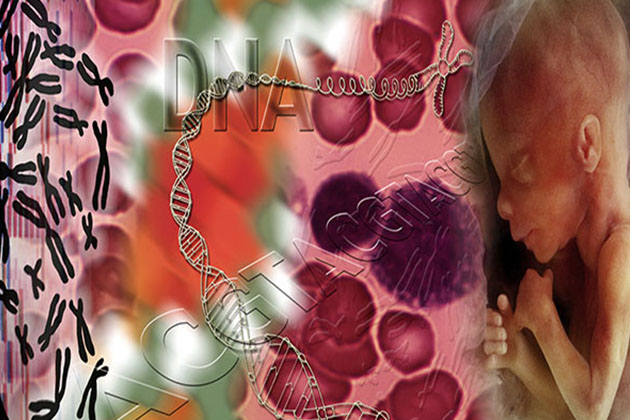Studiul arată promițător pentru tratarea bolilor genetice la un mamifer în timpul dezvoltării fetale în primele trei luni de sarcină
A genetic tulburarea este o afecțiune sau o boală care este cauzată de modificări sau mutații anormale ale ADN-ului unei persoane în genă. Al nostru ADN-ul provides the required code for making proteins which then perform most of the functions in our body. Even if one section of our DNA gets altered in some way, the protein associated with it can no longer carry out its normal function. Depending upon where this change happens either it can have a little or no effect or it might alter the cells so much that it could then lead to a genetic disorder or illness. Such changes are caused by errors in DNA replication (duplication) during growth, or environmental factors, lifestyle, smoking and exposure to radiation. Such disorders are passed on to the offspring and start to occur when the baby is developing in mother’s uterus and are therefore referred to as ‘birth defects’.
Birth defects can be minor or extremely severe and may affect appearance, function of an organ and some aspect of physical or mental development. Millions of children are born annually with serious genetic conditions. These defects can be detected during pregnancy as they are evident within the first three months of pregnancy when the organs are still forming. A technique called amniocentesis is available for detecting genetic abnormalities in the foetus by testing amniotic fluid extracted from the uterus. However, even with amniocentesis, treating them is not possible as no options are available to make any corrections before birth of the baby. Some of the defects are harmless and require no intervention but some others can be of serious nature and may require long-term treatment or even be fatal for the infant. Some defects can be corrected shortly after birth of the baby – example within a week’s time – but mostly it is too late for treatment.
conservare genetic condition in an unborn baby
For the first time the revolutionary gene editing technique has been used to cure a ‘genetic disorder’ in mice during foetal development in the uterus in a study by researchers at Carnegie Mellon University and Yale University. It is well established that during early development in the embryo (during first three months of a pregnancy) there are many stem cells (an undifferentiated cell type which can become any type of cell upon maturation) that are dividing at a fast rate. This is the pertinent time point where a genetic mutation if corrected would reduce the impact of the mutation on embryo-to-foetal development. There are chances that a severe genetic condition could even be cured and the baby is born without the unintended birth defects.
În acest studiu publicat în Natura Comunicaţii researchers have used a peptide nucleic acid-based gene editing technique. This technique has been used before to treat beta thalassemia – a genetic blood disorder in which haemoglobin (HB) produced in the blood is reduced considerably which then affects normal oxygen supply to various parts of the body leading to severe abnormal consequences. In this technique, unique synthetic molecules called peptide nucleic acids (PNAs) (made of a combination of synthetic protein backbone with DNA and RNA) were created. A nanoparticle was then used to transport these PNA molecules along with “healthy and normal” donor DNA to the location of a genetic mutation. The complex of PNA and DNA identifies the designated mutation at a site, PNA molecule then binds and unzips the double helix of mutated or faulty DNA. Lastly, donor DNA binds with the mutated DNA and automates a mechanism to correct the DNA error. The main significance of this study is that it was done in a foetus, thus researchers had to use a method analogous to amniocentesis wherein they inserted the PNA complex into the amniotic sac (amniotic fluid) of pregnant mice whose foetuses were carrying the genă mutație care provoacă beta talasemie. După o injecție de PNA, 6% dintre mutații au fost corectate. Acești șoareci au prezentat o îmbunătățire a simptomelor bolii, adică nivelurile de hemoglobină au fost în intervalul normal, ceea ce ar putea fi interpretat ca șoarecii fiind „vindecați” de afecțiune. Ei au arătat, de asemenea, o rată de supraviețuire crescută. Această injecție a fost într-un interval foarte limitat, dar cercetătorii speră că pot fi obținute rate și mai mari de succes dacă injecțiile au fost făcute de mai multe ori.
Studiul este relevant deoarece nu s-au observat ținte în afara țintelor și doar ADN-ul dorit a fost corectat. Tehnicile de editare genetică, cum ar fi CRISPR/Cas9, deși sunt mai ușor de utilizat în scopuri de cercetare, este încă controversată, deoarece taie ADN-ul și efectuează erori în afara locului, deoarece deteriorează și un ADN normal care nu este țintă. Din cauza acestei limitări, ele nu sunt potrivite în mod ideal pentru proiectarea terapiilor. Având în vedere acest factor, metoda prezentată în studiul actual se leagă doar de ADN-ul țintă și îl repară și nu prezintă erori offsite. Această calitate vizată îl face ideal pentru terapii. O astfel de metodă în designul său actual ar putea fi, de asemenea, potențial utilizată pentru a „vindeca” alte afecțiuni în viitor.
***
{Puteți citi lucrarea originală de cercetare făcând clic pe linkul DOI de mai jos în lista surselor citate}
Sursa (s)
Ricciardi AS și colab. 2018. Livrare in utero de nanoparticule pentru editarea genomului specific site-ului. Natura Comunicaţii. https://doi.org/10.1038/s41467-018-04894-2
***






































